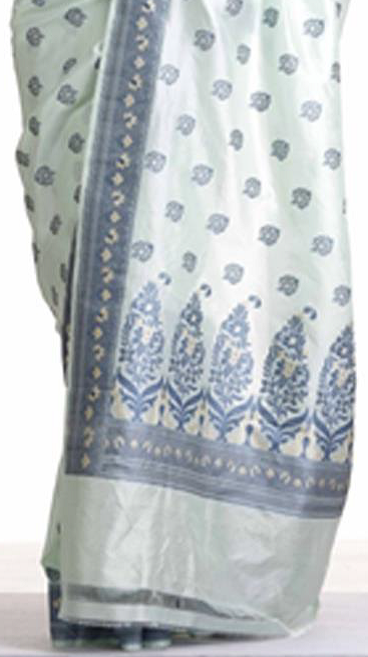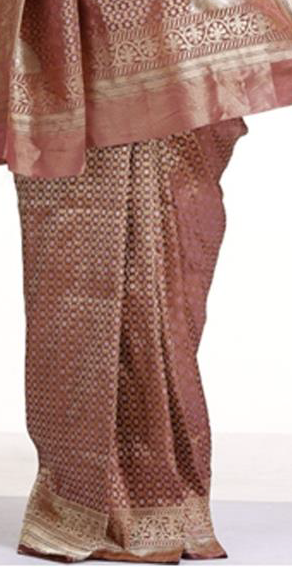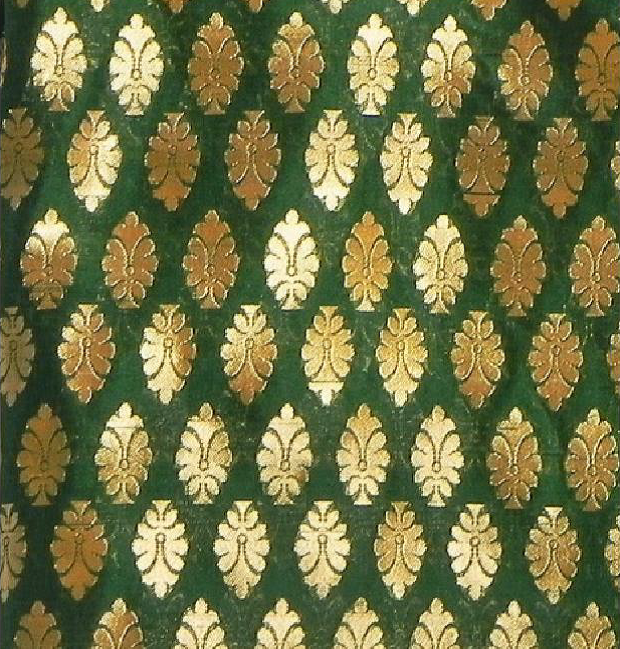Banarasi Butidar Saree, Brocade Silk Saree and Dress Material
Banarasi Butidar Saree, Brocade Silk Saree and Dress Material
Butidar Saree
Background
It is believed that the word ‘Jamdani’ derived from Persian word ‘Jama’ meaning cloth and ‘Dana’ meaning buti or diapering. Jamdani weaving flourished under Mughal Emperors who appreciated the excellence of this Jamdani weaving.
Jamdani is a fine cloth figured with geometric or floral designs. Due to this superfine cloth, handloom weaving had become a fine art in 15th and 16th century. Later in 17th century, this Jamdani fabric was also used for dresses. Presently, Jamdani fabrics are produced in weavers concentrated areas of Burdwan, Nadia districts in West Bengal on frame looms.
Material used
Traditional jamdani fabrics are produced using 100s, 120s and above count of cotton yarns for warp and weft while 4 to 6 ply cotton yarn used for extra weft either in white or dyed . Later they started using Zari also. Now a days jamdani sarees and dress materials are woven with cotton yarn of count ranges from 60s to 100 , using steel reeds of 68 – 72s count.
Weaving Technique
 Jamdani is a weaving technique of figured cotton textiles, in transparent plain ground, with designs of extra weft. Design motifs are directly woven by weavers from their memory without the help of any design device. They adapted a traditional and indigenous technique which involves ‘throw shuttle’ (presently fly shuttle is used) and extra weft insertion by needle. Jamdhani motifs are known by different names viz. ‘panna’, ‘hajar’, ‘dubli’, ‘jal’, ‘butidar’, ‘tersa’, ‘charkona’ ,’fulwar’, ‘duria’,’belwari’ etc. depending upon the arrangements . Motifs of Jamdani fabrics are mainly of geometrical and floral concepts adopted from local environment like flowers, leaves, mango, zig-zag lines etc. Also, it covers ‘Hazzar buti (One thousand) , Tagar ful, Bokul ful , Dorakata, Mala etc. The special design pattern of paisley motif in the corners of palloo portion, locally known as ‘konia’ is produced by skilled Jamdani weavers.
Jamdani is a weaving technique of figured cotton textiles, in transparent plain ground, with designs of extra weft. Design motifs are directly woven by weavers from their memory without the help of any design device. They adapted a traditional and indigenous technique which involves ‘throw shuttle’ (presently fly shuttle is used) and extra weft insertion by needle. Jamdhani motifs are known by different names viz. ‘panna’, ‘hajar’, ‘dubli’, ‘jal’, ‘butidar’, ‘tersa’, ‘charkona’ ,’fulwar’, ‘duria’,’belwari’ etc. depending upon the arrangements . Motifs of Jamdani fabrics are mainly of geometrical and floral concepts adopted from local environment like flowers, leaves, mango, zig-zag lines etc. Also, it covers ‘Hazzar buti (One thousand) , Tagar ful, Bokul ful , Dorakata, Mala etc. The special design pattern of paisley motif in the corners of palloo portion, locally known as ‘konia’ is produced by skilled Jamdani weavers.
How to distinguish genuine Jamdani Saree
- Jamdani fabrics can easily be distinguished by seeing the extra weft which is usually inserted in the ratio of two ground thread and one design thread.
- Bulging effect is seen at the design portions of the fabric since design thread is coarser than ground thread.
- The extra un-cut weft is interlaced with warp threads to form the design from left to right and vice versa in such a way that it cannot be pulled off.
- Turning of design thread from left to right and vice versa is clearly seen in the back side of the fabric.
Banaras Brocade Saree
Background
 During the Mughal period, around 14th century, weaving of brocades with intricate designs using gold and silver threads became the specialty of Banaras. The Banaras Brocade sarees are made of finely woven silk and decorated with intricate design using jari and because of these ornamentations it is relatively heavy. Their special characteristics are Mughal inspired designs/elements such as intricate floral and foliate motifs kalga and bel. Other features are gold work, compact weaving, figures with small details, metallic visual effects, jal (a net like pattern) and meena work.
During the Mughal period, around 14th century, weaving of brocades with intricate designs using gold and silver threads became the specialty of Banaras. The Banaras Brocade sarees are made of finely woven silk and decorated with intricate design using jari and because of these ornamentations it is relatively heavy. Their special characteristics are Mughal inspired designs/elements such as intricate floral and foliate motifs kalga and bel. Other features are gold work, compact weaving, figures with small details, metallic visual effects, jal (a net like pattern) and meena work.
Material used
Two fold twisted mulberry silk yarn, locally called “Katan” is used in both ground warp & weft with gold and / or silver zari for designing.
Techniques applied
Banaras brocade sarees and woven on conventional Banaras handloom jacquard and sometimes with jala, pagia & naka attachment for creation of motif. For weaving of ground fabric 5 to 8 heald shafts are used for ground fabric and designs are woven in weft of different materials and colours. Satin weave is used in the ground fabric.
How to distinguish Banaras Brocade
- The Banaras brocade made of silk and jari are heavily designed with intricate floral and / or spotted motifs.
- Satin weave used in the base fabric.
- Metallic visual effects prominently appears in the fabric.
- Floats of wefts are not found in face or in back side of the fabric.
- It has heavy weight due to use of metallic yarn and compound texture.
Banaras Butidar Dress Material
Background
Banarasisaree is woven in pious city of Varanasi and is popular throughout the country. The sarees are known for their gold and silver zari brocade work. The sarees are woven in silk and are decorated with intricate extra-weft design. The design is mainly inspired by the Mughal pattern.

This fabric is woven using “Karuwa” or “ Fekua” technique. The “Karuwa” technique involves using many numbers of “sirkies” (spools) for making butis whereas Fekua involves throwingof shuttle from one end to the other end.
Material used
Traditional Butidar fabrics are produced using 100s,120s and above count of cotton yarns for warp and weft while 4 to 6 ply cotton yarn used for extra weft either in white or dyed . Later they started using Zari also.
Weaving Technique
This Fabric is woven using “Karuwa” or “ Fekua” technique. The “Karuwa” technique involves using many numbers of “sirkies” (spools) for making butis whereas Fekua involves throwingof shuttle from one end to the other end.
How to distinguish genuine BanarasiButidar Dress Material
- Butidar fabrics can easily be distinguished by seeing the Buta/ Buti all over the surface.
- It is woven either by Karhwa/Fekua technique of weaving. In Karhwa technique, extra float is not visible on backside of fabric, whereas in Fekua the backside of the saree has float, which may or may not be cut.
- Butis are arranged in straight /half drop/any other pattern of repeat.
Source : Indian Handloom Brands
Last Modified : 9/4/2023
This topic provides information about Arni Silk Sa...
This topic provides information about Venkatagiri ...
This topic provides information about Tussar Gichh...
This topic provides information about Tweed.
